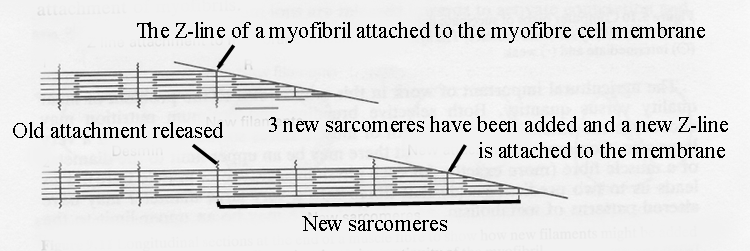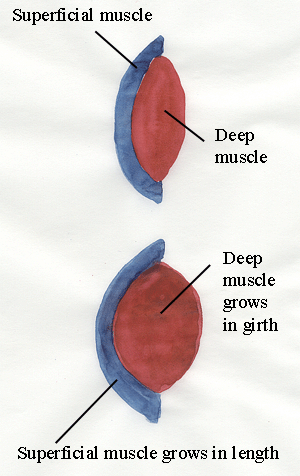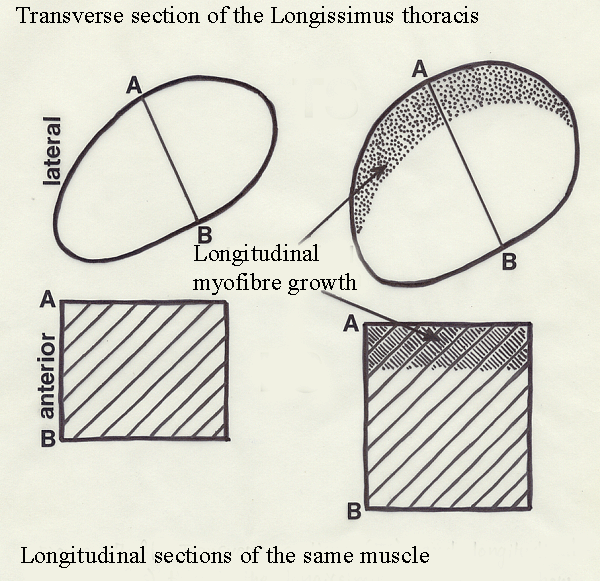24 Longitudinal Growth of Muscles
24.1 Introduction
Think of the length of any major muscle in a calf or piglet,
then think of the length of the same muscle in a commercial beef or
pork carcass. There has been a major increase in length. Thus, longitudinal growth of whole muscles
makes a major contribution to meat production in all our meat animals.
But the longitudinal growth of individual muscles is achieved by
the longitudinal growth of individual myofibres, which is complicated
by the angular insertion of myofibres in most muscle. Only a few
muscle like the Sartorius in
the hindlimb have parallel myofibres. In
most muscles, the myofibres are arranged at angles to modify the
effects of individual myofibre contraction. If a myofibre contracts
over a greater distance than the length of the whole muscle, then
leverage is obtained and the force of contraction is magnified at the
expense of distance. Often distance and force are unchanged
but the
angular arrangement of myofibres allows more myofibres to be connected
to the tendon than would be possible if the myofibres were all parallel.

When myofibres have an angular insertion, the muscle is said to be pennate, as in the example above.
This type of muscle is very common in less expensive cuts of meat such
as the shank meat of the legs. The large amount of intramuscular collagen makes these
muscles very tough unless they are given long cooking with moist heat.
24.2 Longitudinal growth of myofibres
- Even when the
longitudinal axes
of myofibres and their fasciculi are parallel to the longitudinal axis
of a
whole muscle, it is extremely difficult to ascertain the length of
individual
myofibres.
- Longitudinal growth originates
from the formation of new sarcomeres at
the ends of myofibres.
- The addition of new sarcomeres
is regulated. Sarcomere length and the degree of overlap of thick and
thin filaments must be maintained at an optimum for efficient muscle
contraction.
- Regulation may be mediated by the protein dystrophin as a
mechanochemical transducer.
- However, the system must be very complex, because sarcomere
length shortening during contraction differs between muscles and is
related to the
angular changes of nearby skeletal joints.
- Myofibrils insert obliquely
at their ends. This enables new myofilaments to be added without
interfering with the mechanical continuity of the myofibrils at their
attachment
to the cell membrane.
- The ratio of muscle belly length
to free tendon length remains approximately constant during growth.

Rabbit
muscles have been marked with ink and implanted wires to find where new
muscle tissue is added
during longitudinal growth. New tissue is added evenly along the muscle
length
- rather than being restricted to the ends of the muscle. But remember
- many myofibres terminate intrafascicularly with tapered endings. The
problem with this type
of experiment is the possibility of ink marks or wire implants
following the growth of intramuscular connective tissue rather than the
growth of myofibres.
- An increase in the
girth of a
deep muscle (usually from the radial hypertrophy of myofibres) causes
overlying superficial muscles to bulge outwards.
- Thus, the dominant pattern of
cellular growth in the superficial
muscle may be longitudinal
growth, since its
length from origin to insertion is increased in a curvilinear manner as
the
deep muscle bulges outwards.
- This is why a subjective assessment of muscle bulging in a
carcass can be used in carcass evaluation as a guide to
muscularity (it is used in many types of beef carcass grading).
- The
longitudinal growth of muscles
follows that of the skeleton. Thus, bone length is related to meat
yield.

24.3 Fascicular length
In complex carcass muscles it
may be possible to measure fascicular length, although fascicular
length
conveys no information about nyofibre length unless the distribution of
intrafascicularly
terminating muscle fibers is known. Fascicular length is one of the factors
contributing to the cross sectional area of the longissimus dorsi
muscle.
The width and the depth of longissimus dorsi have long been recognized
as
partially independent variables, with depth being a more sensitive
indicator
than width for the prediction of muscularity. For example, ewes
fed at a supermaintenance level show proportionately greater gains in
depth
relative to width. Similarly, submaintenance feeding causes a greater
reduction
in depth than in width. In pork carcasses, the width of the
longissimus dorsi is more strongly correlated with total carcass muscle
than is
depth. Width is
weakly correlated with myofibre diameter whereas depth is not
correlated with myofibre diameter.
-
The partial independence of
depth and width in the longissimus dorsi is caused by muscle fasciculi
passing through the muscle cross sectional area in a plane parallel to
depth.
-
Thus, when fasciculi grow in length, they contribute
to depth but not to width.
-
When the longitudinal growth of fasciculi is
proportionately
faster than growth in muscle length, the increased dorsal overlapping
of
fasciculi causes an increase in the apparent numbers of myofibres
(explained below).
-
Every millimetre of gain in fascicular
length adds 0.77 mm to the depth of the Longissimus thoracis (the
thoracic part of Longissimus dorsi) in a pork carcass.

24.4 Rate of new sarcomere formation
About every 20 minutes, a new
sarcomere is added to the length of myofibres in pigs growing
to market weight. In muscles with relays of
intrafascicularly terminating fibers along their length, or relays of
fasciculi
along their length, the number of points at which longitudinal growth
occurs is
increased. If two growth points, one at each end of a myofibre, can add
a sarcomere every 20 minutes, then the formation of each sarcomere
must take about 40 minutes. Thus, a muscle with four relays of
intrafascicularly terminating myofibres (or four relays of fasciculi)
might add a
new sarcomere to its length in about 5 minutes because it has eight
points for
longitudinal growth. Hence, in pigs growing to market weight, muscles
deep in
the ham may add a new sarcomere to the length of the muscle every five
minutes
but, in superficial muscles which are increasing in length at a faster
rate,
the time for sarcomere addition may be as short as two minutes.
Using the number of sarcomeres
along the length of a fasciculus as a measure ot its length, some
interesting
growth patterns have been detected in turkey muscle. The pattern of
growth in the parallel-fibred sartorius is a simple
decelerating curve to reach a plateau at about 15 weeks with males
having
longer muscles than females. In the
pennate supracoracoideus, trapped in an osteofascial compartment
limiting
growth against the keel of the sternum, fascicular length reaches a
maximum at
13 to 14 weeks and then may decline, with only slightly longer
fasciculi in
males than females.
(The osteofascial compartment is formed by a sheet of connective tissue
trapping the muscle in a depression on the sternum).
24.5 Apparent number of myofibres
From the diagram below, we can see the number of myofibres appearing
at the midlength of a muscle
may be less than the real
number of myofibres in the muscle. Myofibres can terminate
intrafascicularly along the length of a muscle. When they grow in
length, they cause an increase in the apparent number of
myofibres (but there has been no change in the real number!).

Likewise, if myofibre longitudinal growth is LESS than in the whole
muscle, the apparent number may decrease. Increases in apparent
number occur in young animals. Decreases in apparent number occur
in older animals.
Further information
Structure and Development of Meat
Animals and Poultry. Pages 396-401.





